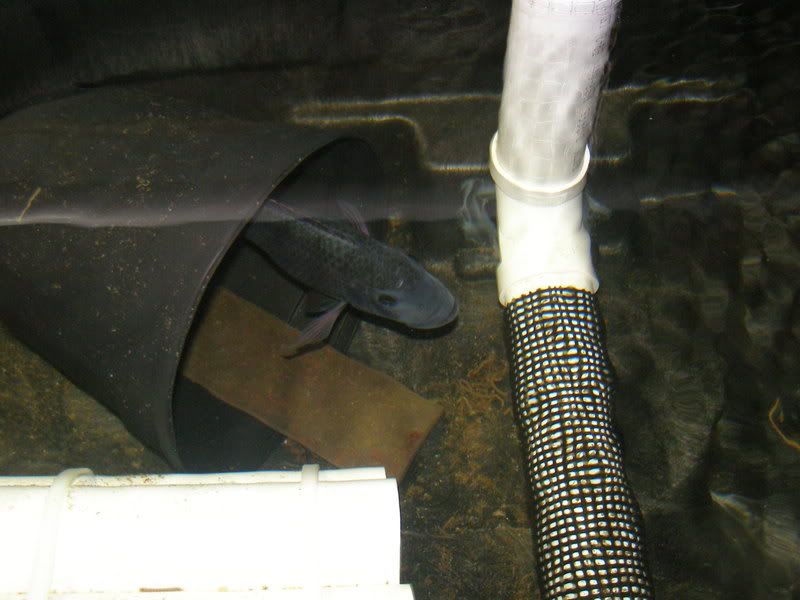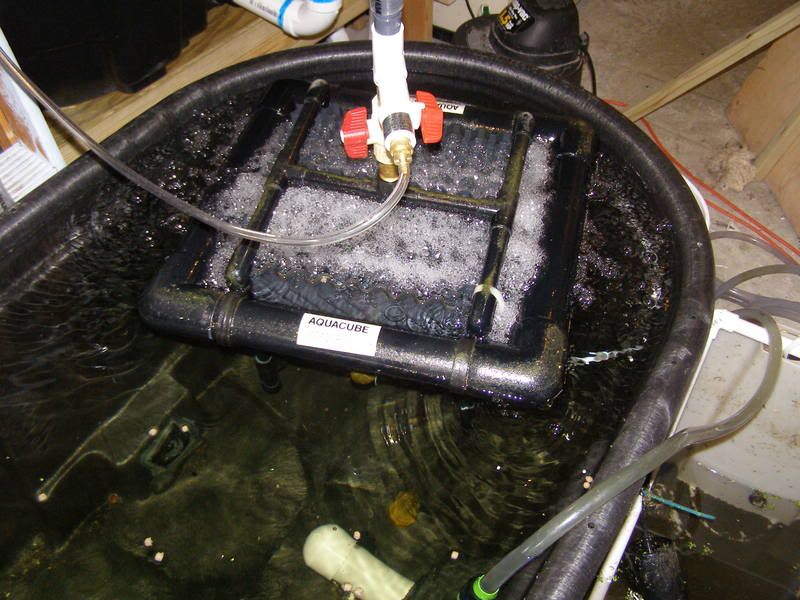My main recirculating system is currently in my basement. I'll be hopefully moving it to my greenhouse once I get it built. The primary function is to breed tilapia and sell fry.
When it was first built I used Rubbermaid 100 gallon stock tanks. I am now in the process of converting some over to glass. The current system has 4 stock tanks and 3 glass tanks.
Here is a shot of the outside of my double decker tanks. I built wooden shelves to hold one tank above the other to optimize space:
It is plumbed with 2" PVC pipe. I removed the drain fittings, enlarged the hole and replaced it with 2" bulkhead fittings. The loop you see on the outside maintains a constant water level in the tank.
This is a shot of the inside:
In the 1st picture you see the pipe that fits into the bulkhead fitting. I drilled 1" holes along the bottom of the pipe and covered it with screened tubing. This allows the system to take a suction off the bottom and pick up the fish solids. The second picture shows my fail-safe and also the water supply. The fail-safe takes the pipe and continues it to the surface just above the normal water level. I put some screened tubing over that to keep the fish out. If the bottom plugs for some reason, the water level would rise and go out the overflow.
The inlet piping is one inch. It starts off as 1.5" at the filter and drops in size as the water is distributed. The idea is to maintain a constant water velocity and smaller pipe and valves are also cheaper. The valves allow me to regulate flow to each tank.
Piping returns the water to a central sump. In the sump is my primary biological filter as there are no plants in this system. I use a clever device called an aquacube:
4 large 8" air stones sit underneath and provide bubbles to move the water through a series of baffles. The baffles support the bacteria that do the bio filtration. The water is saturated with oxygen, so they do an awesome job. It can't clog and never needs cleaning. It also moves about 50 gallons per minute through the filter allowing bio filtration for thousands of tilapia in a larger pool type system. I use a small regenerative blower to provide the system with the air it needs. Each tank has a separate 6" airstone and the blower and pump are off separate circuits in case one blows.
I use a small 1/2 horse pool pump and standard Hayward sand filter to remove the particulates. This requires a back-wash about every 3rd day. The sand has been replaced with plastic permabeads which don't break down like sand. They also proved a fair amount of bio filtration once they are in use for a while. The back-wash gets settled out and de-watered and the solids go into my worm bin. Once I get the grow-beds up in the greenhouse, the back-wash will go to the beds.
The system is heated with 2 1KW bucket heaters I found at a farm supply place. I have them hooked up to a digital Honeywell thermostat. The heaters are only about $25 each, and the thermostat was $60, so for $110 I have enough heat for them. As you might imagine, the electric bill went up. I also have a back-up generator, just in case the lights go out.
I've replaced two of the tanks with glass ones since I set the system up. It is far easier to tell if the females are holding fry. For grow-out tanks, the tubs are fine.
Results 1 to 10 of 42
Thread: My 700 gallon basement system
Hybrid View
-
02-22-2009, 03:35 PM #1
My 700 gallon basement system
The best fertilizer is the farmer's shadow
Similar Threads
-
My new basement system!
By Prometheus7504 in forum Back Yard SystemsReplies: 3Last Post: 12-17-2014, 04:08 PM -
Backyard 600 gallon IBC system
By dsrtlzrd32 in forum Back Yard SystemsReplies: 11Last Post: 03-22-2013, 11:55 AM -
Keith's basement winter system
By keith_r in forum Back Yard SystemsReplies: 62Last Post: 10-01-2012, 07:02 AM -
Basement System Design
By Bioritize in forum Want To Know HOW TO..?Replies: 33Last Post: 03-22-2012, 03:03 AM -
100 gallon hobby system
By tayl0r in forum Back Yard SystemsReplies: 4Last Post: 08-14-2009, 04:13 AM








 Reply With Quote
Reply With Quote
